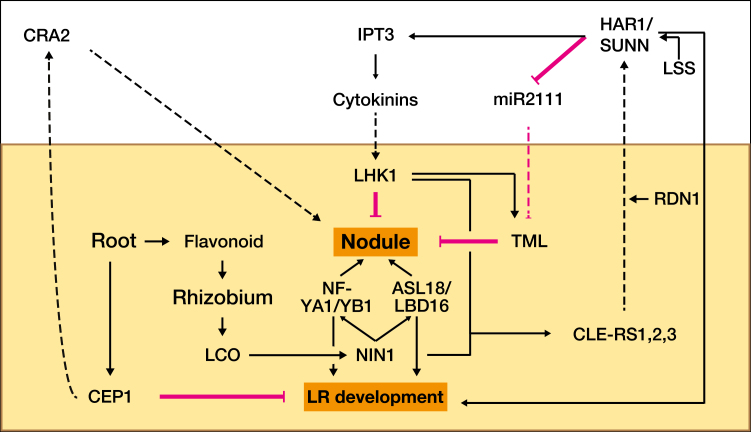Fig. 2.
Autoregulation of nodulation (AON). Low N levels induce roots to produce flavonoids which stimulate rhizosphere-associated rhizobia to produce LCO. In L. japonicus, these regulate the major transcription factor NIN which activates both NF subunits YA1/YB1 as well as ASL18/LBD16, whose interaction initiates nodulation and nodule development. NIN also induces the expression of genes coding for nodulation-suppressing CLE peptides [mainly CLE ROOT SIGNAL 1 and 2 (CLE-RS1/2)], which are transported to the shoot and perceived by their receptor HAR1. This results in decreased accumulation and shoot–root mobilization of miR2111, which negatively regulates the nodulation suppressor TML. CLE–HAR1 interaction also leads to higher CK synthesis and signalling due to increased expression of IPTG3 and CK translocation to the roots to suppress further nodulation events through their receptor LHK1. This receptor also induces the expression of CLE-RS3, inducing a positive feedback loop on its own regulation, and is required for TML effect in the root cortex. In M. truncatula, low N conditions also stimulate roots to synthetize CEP1, which is mobilized to the shoot where its candidate receptor CRA2 positively regulates nodulation. RDN1 arabinosylates rhizobia-induced CLE12, similar to how CLE-RS2 is arabinosylated in L. japonicus to interact with HAR1, while LSS (LIKE SUNN SUPERNODULATOR) also further regulates the expression of the HAR1 orthologue SUNN. Mutations in these genes affect LR development since they also participate in the plant response to external N. Finally, NF-YA1/YB1 and ASL18/LBD16 have positive roles in LR development. Together, these genetic interactions show how several of the genes implicated in nodule development and the AON pathway overlap with those that regulate LR development. Black lines with arrowheads signify a positive effect while blunt-ended magenta lines indicate a negative effect. Solid lines indicate regulation while dashed lines signal mobilization to a different plant organ. Nodule and LR development are highlighted and in bold. Light brown indicates below-ground.

